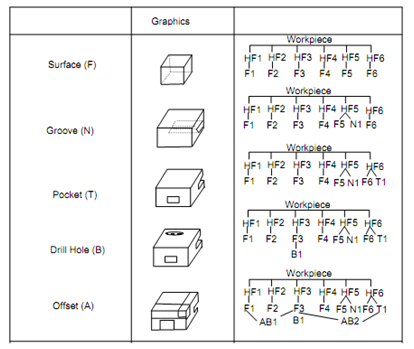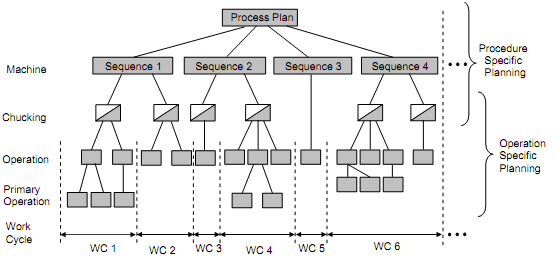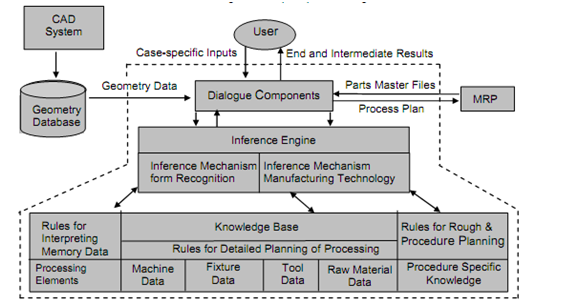Knowledge Based System
Next, the knowledge-based system, EXPLAN, is briefly described. This system is a subproject of the research project on the factory of the future, as part of the European research initiative called EUREKA. To build a comprehensive system, it is important that a proper model is established. This system models the process planning world by three approaches: work piece geometry, machining, and planning.
The machining model encompasses various types of planning knowledge, such as the operations and the sequence of operations needed to remove part of the material. It represents the process plan schematically and includes knowledge of how each sequence of operations, such as setup and clamping, is performed. Rough and finish cutting is also associated with particular machining operations. Figure 7 shows how a process plan is represented and its structure.

Figure 7: Processing Element Representation Scheme
The planning model is the portion in which the clamping positions and other factors are taken into account of the purpose of reducing cost. For example, allocating different sets of BEs to a certain setup may affect the manufacturing cost. Usually, we try to maximize the work content of each individual setup, which helps to achieve the ultimate goal of reducing the total cost of a product.

Figure 7: Schematic Representation of a Process Plan
- Procedure-specific Planning: Cycle oriented rough planning of the workpieces and detailed planning of simple processing procedure
- Operation-specific Planning: Detail planning of the work operations in individual chucking with help of processing elements
The overall structure of the EXPLAN system is shown in Figure 7. Three basic components of the system are knowledge base, dialogue, and inference engine. The dialogue component connects the users and the system and defines how the users can use the inference engine. Also, the link with external data files such as material requirements planning (MRP) and CAD database is included in this component.

Figure 7:Overall Structure of the EXPLAN System
The inference engine is used to apply rules for certain application and obtain the result. For example, we apply the rules for interpreting geometry data when we try to interpret the geometry data from the CAD database. When generating a detailed process plan, the rules for detailed planning of processing are used by inference engine to obtain a plan to achieve a certain goal.
The knowledge base contains the experience of experts, usually written in a certain format for easy inference. Here the knowledge is in the form of rules. For example, a rule for interpreting the geometry may be: If the angle between two external surfaces of the workpiece is smaller (greater) than 180°, there is an internal (external) edge. From a set of rules, the inference engine may produce some useful new knowledge such as whether the edges form a particular processing element.